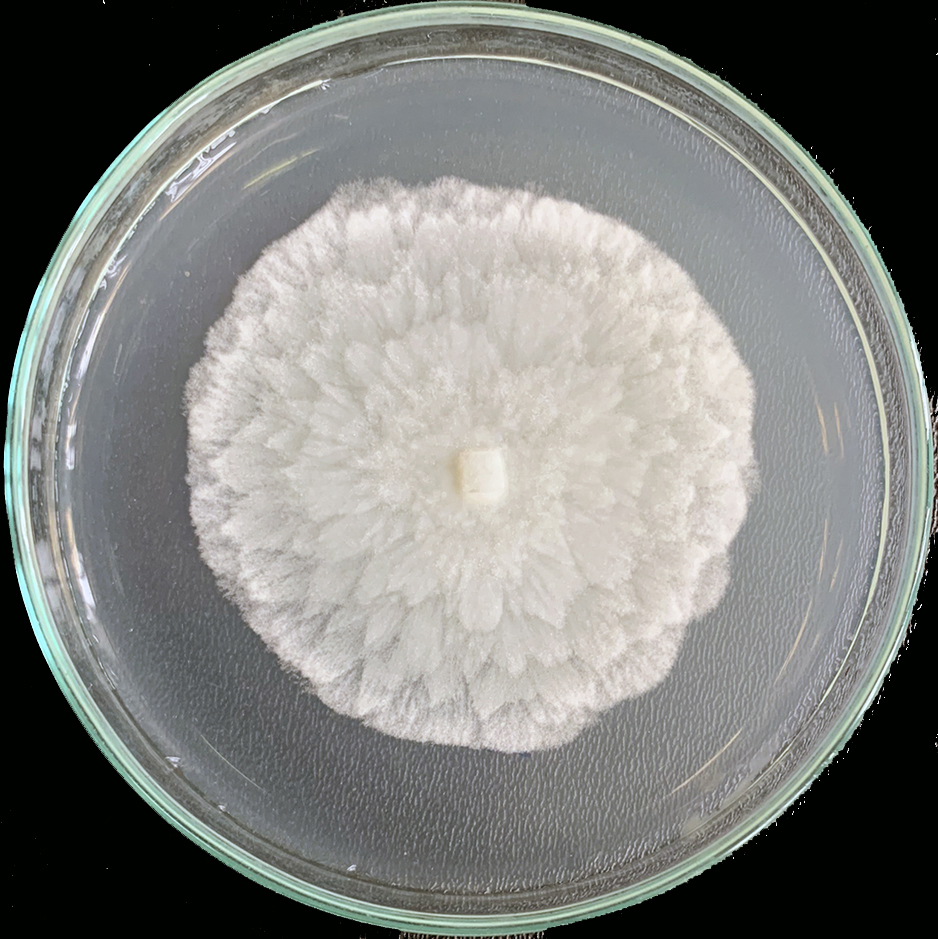Phytophthora docyniae
|
Phytophthora spp. in subclade 9c: portion of the seven-loci ML phylogeny featuring the type cultures of 212 described species (by T. Bourret). Notice the position of P. docyniae Ex-type CBS 148031. Gloria Abad, USDA S&T.
|
|
Phytophthora spp. in subclade 9c: Morphological Tabular key (PDF) and Tabular key legends (PDF) in IDphy2 KEY SECTION. Notice the data of P. docyniae Ex-type CBS 148031. Gloria Abad, USDA S&T.
|
|
chrysanthemum colony morphology after 7 d growth at 20ºC on potato dextrose agar |
|
ovoid sporangia with direct germination; internal nested and extended proliferation; intercalary chlamydospore; thick-walled chlamydospore on PDA, chlamydospores germinating to produce sporangia; chlamydospores and hyphal swelling with projections; scale bar = 40µm |
Name and publication
Phytophthora docyniae Q.N. Dang, T.H. Nguyen & T.I. Burgess (2021)
Quynh. N. Dang, Thu. H. Nguyen, Hung. X. Tran & Thu. Q. Pham, Burgess TI. 2021. Phytophthora docyniae. Fungal Planet 1374. in Crous et al. Fungal Planet Description Sheets 1284–1382. Persoonia 47: 1–150.
Nomenclature
Mycobank
Etymology
refers to the genus name of the only known host, Docynia indica
Typification
Type: Vietnam, Yen Bai province, Mu Cang Chai, isolated from the soil and root of Docynia indica, collected by VL Binh & XT Hung, Oct. 2019, holotype CBS H-24780
Ex-type: culture CBS 148031
Sequences for ex-type in original manuscript: ITS MZ420209, β-tubulin MZ435255, cox1 MZ435257, LSU MZ435254
Ex-type in other collections
(ET) CBS 148031, FP77
Molecular identification
Voucher sequences for barcoding genes (ITS rDNA and COI) of the ex-type (see Molecular protocols page)
Phytophthora docyniae ITS rDNA, COI
Voucher sequences for Molecular Toolbox with seven genes (ITS, β-tub, COI, EF1α, HSP90, L10, and YPT1
(see Molecular protocols page) (In Progress)
Voucher sequences for Metabarcoding High-throughput Sequencing (HTS) Technologies [Molecular Operational Taxonomic Unit (MOTU)]
(see Molecular protocols page) (In Progress)
Sequences with multiple genes for ex-type in other sources
- NCBI: Phytophthora docyniae
- EPPO-Q-bank: Phytophthora docyniae
- BOLDSYSTEMS: Phytophthora docyniae
Position in multigenic phylogeny with 7 genes (ITS, β-tub, COI, EF1α, HSP90, L10, and YPT1)
Clade clade:
a taxonomic group of organisms classified together on the basis of homologous features traced to a common ancestor
9c
Morphological identification
Colony and cardinal temperatures
Colony colony:
assemblage of hyphae which usually develops form a single source and grows in a coordinated way
have a chrysanthemum pattern on PDA and V8A and are uniform on CA. Minimum growth temperature 15°C, optimum 27.5°C, and maximum 35°C.
Conditions for growth and sporulation
SporangiaSporangia:
sac within which zoospores form, especially when water is cooled to about 10°C below ambient temperature; in solid substrates, sporangia usually germinate by germ tubes
are produced in water cultures (soil extract) and not observed in solid media. OogoniaOogonia:
the female gametangium in which the oospore forms after fertilization by the antheridium
not formed in single or paired cultures.
Asexual phase
SporangiaSporangia:
sac within which zoospores form, especially when water is cooled to about 10°C below ambient temperature; in solid substrates, sporangia usually germinate by germ tubes
were non-papillate, persistentpersistent:
pertaining to sporangia that remain attached to the sporangiophore and do not separate or detach easily (cf. caducous)
, and predominantly ellipsoidellipsoid:
refers to a solid body that forms an ellipse in the longitudinal plane and a circle in cross section; many fungal spores are ellipsoidal or elliptic
to ovoidovoid:
egg-shaped, with the widest part at the base of the sporangium and the narrow part at the apex
in shape with internal proliferationinternal proliferation:
internal proliferation occurs when the sporangiophore continues to grow through an empty sporangium
, both nested and extended. SporangiaSporangia:
sac within which zoospores form, especially when water is cooled to about 10°C below ambient temperature; in solid substrates, sporangia usually germinate by germ tubes
averaged 34.5 x 23.8 µm (overall range 30–39.5 x 19.8–27.9 µm), direct germination of sporangiasporangia:
sac within which zoospores form, especially when water is cooled to about 10°C below ambient temperature; in solid substrates, sporangia usually germinate by germ tubes
with unusual shapes was observed. Sporangiophores simple. Hyphal swellings present. ChlamydosporesChlamydospores:
an asexual spore with a thickened inner wall that is delimited from the mycelium by a septum; may be terminal or intercalary, and survives for long periods in soil
present.
Sexual phase
Sterile in culture
Most typical characters
Phytophthora docyniae resides in cladeclade:
a taxonomic group of organisms classified together on the basis of homologous features traced to a common ancestor
9c most closely related to P. macrochlamydospora and P. quininea. Compared to the other species it has very small sporangiasporangia:
sac within which zoospores form, especially when water is cooled to about 10°C below ambient temperature; in solid substrates, sporangia usually germinate by germ tubes
which often directly germinate before releasing zoosporeszoospores:
motile spore that forms within the sporangium and exits through the exit pore and is capable of swimming for several hours; it has both a tinsel flagellum and a whip-like flagellum
.
Additional specimen(s) evaluated
Vietnam, Yen Bai province, Mu Cang Chai, isolated from the soil and root of Docynia indica, VL Binh & XT Hung, 2019, CBS 148031; FP78
Hosts and distribution
Distribution: Vietnam
Substrate: roots
Disease note: root rot of Docynia indica
Host: Docynia indica
Additional references and links
- SMML USDA-ARS: Phytophthora docyniae
- EPPO Global Database: Phytophthora docyniae
- Forest Phytophthoras of the World: Phytophthora docyniae
- CABI Digital Library: Phytophthora docyniae
- Encyclopedia of Life (EOL): Phytophthora docyniae
- Index Fungorum (IF): Phytophthora docyniae
Fact sheet author
Treena Burgess, Ph.D., Phytophthora Science and Management, Harry Butler Institute, Murdoch University, Australia
Z. Gloria Abad, Ph.D., USDA-APHIS-PPQ-S&T Plant Pathogen Confirmatory Diagnostics Laboratory (PPCDL), United States of America.



